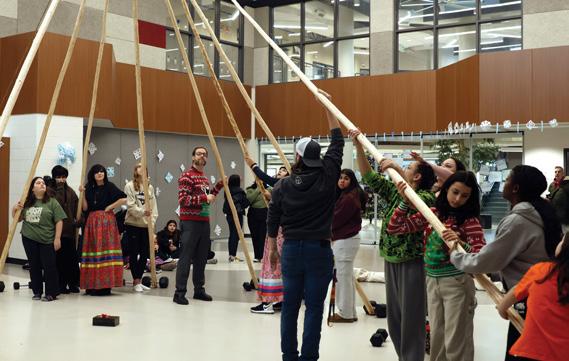









Roundabout Coming to Hwy 311



































C h r i s t i a n E d u c a t i o n i n N i v e r v i l l e !
















































C h r i s t i a n E d u c a t i o n i n N i v e r v i l l e !


By Uriel Doukler
The second annual Edge Business Expo will return to Ritchot on January 22–23, 2025. For the second consecutive year, it will take place at the TC Energy Centre in Île-des-Chênes.
The first evening will give attendees an opportunity to network with industry leaders, explore local businesses at the tradeshow, and discover new opportunities. Starting at 5:00 p.m., guests will have a chance to sample delicious foods from a variety of local food trucks, as well as enjoy cocktails provided by Nomad Box Bar.
Starting at 8:00 a.m., the second day will present a full agenda with various seminars and workshops, a tradeshow featuring more than 30 exhibitors, and keynote presentations.
A highlight will be a lunch break address by David Chilton, Canadian bestselling author of The Wealthy Barber and a former dragon of Dragons’ Den fame. His talk will get underway at 11:30 a.m.
Chilton will share his wisdom on entrepreneurship, investment strategies, and how to achieve financial success. His engaging style and practical advice are sure to inspire and motivate attendees to take their ventures to the next level.
Expo will feature a diverse lineup of speakers, including Heather Barnes, a major social media influencer known for her DIY and home décor, and Nicole Dubé, former host of CTV Morning Live Winnipeg Both will offer unique perspectives on topics ranging from personal finance management to developing your social media presence and business expansion strategies.
Attendees can choose from eight specialized workshops where they’ll have the opportunity to dive deep into subjects like digital marketing, financial planning, leadership, and scaling a business. With four workshops available to each attendee, the Expo offers a balance of variety and depth, allowing participants to tailor their experience to meet their own professional goals.
Ritchot Mayor Chris Ewen will attend the two-day event and hopes it will help grow the region’s industry.
“I’m going to be there not just as mayor, but as a business owner who’s really invested in local businesses throughout the area,” Ewen says. “I want to participate and encourage people to participate because we’re really going to absorb as much information as we can over those two days.”

the many on-demand seminars and workshops offered and the calibre of the keynote speakers.
“I’m really also encouraging—I can’t stress this enough—the business community and the area in and around Ritchot to get their tickets before they’re gone,” he says. “We are anticipating soldout crowds of over 200 people because of the draw-ins we have that day with David Chilton, Nicole Dubé, and Heather Barnes. Those three names alone are going to bring in so much attention. This will sell out very fast.”
Ewes is excited about the event’s potential to impact the entire municipality, and he can’t wait to show visitors to the area what Ritchot has to offer.
“We’re really going to showcase everything that you can do in our municipality and it’s going to be something wild,” he says. “That’s the best way to put it. This is going to be a wild and great event to be a part of.”
Tickets are available $15 for those who only wish to attend the mixer, and $150 for full access to both days, including all workshops and keynote presentations.







In addition to Chilton, the

Ewen believes the event will sell out sooner than expected, based on

Tickets

By Brenda Sawatzky
LOCAL JOURNALISM INITIATIVE REPORTER
m bsawatzky@nivervillecitizen.com
It’s officially 2025 and already the previous year feels like a complete blur. Before we set our sights on the future, though, let’s take a moment to take a glance back.
One of the most startling stories to hit our region last year began in the wee hours of a summer morning, bringing tragedy to Niverville’s doorstep.
On June 5, residents awoke to news of a police confrontation in front of the Shell station on the west side of town. As the day unfolded, locals learned that one man was dead as a result of RCMP gunfire and two more suspected criminals had fled the scene in a stolen vehicle.
David Frank Burling, 29, was arrested in rural Saskatchewan after a chase across two provinces that ended later in the day. The woman in his company was eventually released without charges.
Burling and his deceased accomplice, Tristan Mariash, had a long history with the law. Both had received early release from prison months prior.
In February 2023, Burling was charged with attempted murder, assaulting a police officer with a weapon, flight from police, dangerous operation of a motor vehicle, possession of stolen property, and two counts of theft.
After serving just 72 days of a twoand-a-half-year sentence, Burling was at it again.
The manhunt began just after midnight in Winnipeg. Working together, the Winnipeg Police Service and RCMP tracked the trio’s stolen F-350 with the aid of a police helicopter, leading them to Providence University College in Otterburne.
One Otterburne resident recalled waking up to the sound of gunshots near his home on campus.
Proof of the altercation could be seen in the form of a police cruiser on the side of the highway. It contained 14 bullet holes.
The manhunt continued to Niverville, where the criminals were

spotted attempting to steal a different vehicle parked at the Shell station.
Some residents reported being awoken around 3:00 a.m. to the sound of a woman’s screams.
Burling and his female companion successfully fled the scene, but Mariash died when attempts by Niverville EMS to resuscitate him failed.
Perhaps the most tumultuous story came later in the summer, due to a high tide of public criticism over the Winnipeg Metro Region’s (WMR) proposed Plan20-50, a 127-page document intended to operate as a 30-year guide to regional planning for the 18 municipalities making up the capital region, including Niverville and the RM of Ritchot.
Events came to a head on August 8 when a public hearing held by the WMR at the Niverville Heritage Centre was met with hundreds of disgruntled attendees.
Many were turned away due to a lack of seating. RCMP were on site to maintain order.
The August public hearing had to be cancelled. To date, no new hearing has been set and the future of the plan is highly uncertain.
For many attending the meeting that day, Plan20-50 is anything but
innocuous. Many believe it represents a threat to the freedom of movement Manitobans currently enjoy. Terms such as “15-minute city,” “density targets,” and “global agenda” cropped up in conversation and social media for weeks.
One Niverville public council meeting required an RCMP presence. Some Plan20-50 objectors were escorted out when they demanded their voice be heard in a session unrelated to the plan.
In the coming weeks, several councils expressed disenchantment with Plan20-50 and the WMR’s approach, among them the Town of Niverville and Ritchot mayor Chris Ewen.
“This letter is not to express my position either for or against the plan itself, but to indicate my concern about the misinformation and the lack of clarification allowed from the WMR board members,” Ewen said in his public statement.
In part, he referred to a letter from the WMR which requested that board members not communicate about Plan20-50 with their constituents during the public hearing process.
Around the same time, a statement from Niverville’s council conveyed a list of specific concerns, including Niverville’s forced inclusion on the WMR board. Mandated participation from the 18 RMs had been made
official in March 2023.
Late in the summer, Premier Wab Kinew stated his intent to provide an opt-out option for municipalities.
The year also brought turmoil to two local school divisions.
The Seine River School Division (SRSD) was assigned a provincial investigator in January to conduct a deep dive into the division’s troubled finances.
This was in response to the revelation of a $3.1 million deficit reported by the division late in 2023. It was estimated that the deficit would grow to $5.3 million without some deep budget cuts.
The coming weeks required hard work from the SRSD trustee board in terms of cutbacks and tax hikes. The board also faced the prospect of losing a number of teachers who were considering a move at the end of the school year.
If that wasn’t enough, a 15-day strike of custodial workers followed in February, which ended with the trustee board agreeing to a wage increase.
By May, superintendent/CEO Ryan Anderson called it quits. He was replaced by Hanover School Division’s (HSD) Colin Campbell later that summer.
HSD itself underwent a staffing shake-up this past year, with superintendent/CEO Shelley Amos giving notice early in 2024. The role was assumed by Joe Thiessen, a 28-year HSD veteran. And when Campbell left shortly after, he was replaced by Marlin Adrian.
Other big administrative changes came to Niverville High School when Principal Kimberley Funk gave her notice. Funk had been instrumental in opening the school in 2019 and played a significant role in the implementation of a project-based learning program.
Funk was replaced by Paul Grosskopf, new to HSD after years serving as vice principal and instructional coach at École St. Adolphe.
As in the case of the SRSD, the province deemed it necessary to appoint an advisor to the HSD trustee board last year, too. This was the result of accusations of discrimination by a group calling themselves the Hanover Parent Alliance for Diversity (HPAD).
This was the second time in seven years that the HSD board faced such allegations. In both cases, the concerns revolved around the division’s lack of inclusivity for members of the LGBTQ community.
HPAD alleged that the board was attempting to vet teachers who identified with or were sympathetic to the LGBTQ community, a role which traditionally does not fall into the trustees’ wheelhouse.
Late last year, HSD announced staffing cuts for 93 educational assistants due to lack of government follow-through on funding promised through Jordan’s Principle grants.
“In early summer, the regional office for Indigenous Services Canada informed us that, based upon our renewal application for Jordan’s Principle funding, we could proceed with hiring staff for the start of the new school year,” superintendent-CEO Joe Thiessen said. “With this information, we proceeded in good faith that funding was secured. However, over the past few months, responsibility for administering the funding shifted to the federal office of Indigenous Services Canada. This change was introduced without our knowledge

and now requires us to reapply for funding, which we intend to do.”
In the meantime, a good number of HSD’s Indigenous students currently lack the EA supports they’ve become accustomed to in recent years.
Both Ritchot and Niverville saw some significant infrastructure improvements this year.
After years of waiting on the province, residents of Îledes-Chênes are finally driving along a rebuilt Main Street, although construction wasn’t without issues.
It didn’t take long for some locals to criticize the seemingly narrow lanes being created with the development of bump-outs, or parking bubbles, along the street.
Following conversations between the construction company, the RM’s public works department, and an engineering team, it was concluded that wider lanes would be preferable. The already installed concrete curbing was removed and rebuilt, widening the lane from 10 feet, 8 inches to a full 12 feet.
Meanwhile, tendering for St. Adolphe’s Main Street rebuild is scheduled to begin in spring 2025.
Ste. Agathe residents are also adjusting to new traffic flows thanks to the restoration of the Louis Riel Bridge. In its entirety, construction is expected to last well into 2026.
This project, estimated at $48.6 million, will involve a major reconstruction of the structure’s foundation to bring it up to current federal standards. The deck and railings will be replaced, creating wider lanes and shoulders. The sidewalk will be separated from traffic by concrete barriers.
The Louis Riel Bridge was first built in 1959, replacing a ferry system that had transported vehicles across the Red River. It has since served as a vital east-west link, connecting traffic from the east side of the river to Highway 75.
Another significant infrastructure undertaking this year resulted in a large-scale refurbishment of the RM’s civic office building and grounds. The building is now twice as large and includes new council chambers, a brightly lit reception area, and new office spaces. A ribbon-cutting ceremony took place on
October 16.
However, another Ritchot project never made it off the ground. This was Legacy Park in Île-des-Chênes. For more than a decade, council had been working with a planning committee to establish the details of a 40-acre park to be built on land leased from TC Energy.
In July, a statement from the RM revealed that TC Energy had had a change of heart.
“Our plan was to use this land to develop a muchneeded park space in the community,” the RM said.
“Unfortunately, and to our disappointment, TC Energy has stated that they are unable to donate this parcel of land at this time but will work with the municipality to identify other areas they may be able to support the community.”
One month later, a residential development was temporarily put on hold in St. Adolphe. The housing project at 420 Main Street was nearly ready to get underway when newly placed lot boundary markers uncovered an unexpected problem.
On the development side of the markers lay a grave marked by a headstone with the name Marie-Thérèse Leclerc. Leclerc was seven years old at the time of her death and had been laid to rest here, next to the parish cemetery, more than a century earlier.
The story took on a surprising twist when parishioners and longtime St. Adolphe residents began to speak up with knowledge of other historical graves on the site.
It turned out that gravemakers for many children once buried here had been washed away during the 1950 flood. All that had been left to memorialize them was a granite cairn, erected at the southeast corner of the parish property. On that cairn is etched the names of dozens of deceased who are listed in the parish’s records.
In late September, the province sent in an excavation team to determine the degree to which these graves would be disturbed by the residential development.
Later that same week, construction was finally able to get going.
In March, Niverville’s council was taken by surprise when hundreds of residents
showed up to an informational open house on the topic of an opportunity for them to hook up to the town’s water system.
At present, there are still about 700 households using private wells in Niverville. The goal of council that night was to glean public interest in municipal water treatment plant hookup if a significant grant could be obtained to help mitigate homeowner costs.
Passions ran high for many who attended the meeting, worried they were being pushed into a very expensive hookup for a service they didn’t want.
In the end, the mayor and council answered questions as best they could and provided a survey for well owners to fill out. Without an 80 percent buy-in, they said they would not proceed with water treatment plant mainlines through the older sections of the community.
A few weeks later, the results were in. Based on responses from 51 percent of affected homeowners, the answer was a resounding no.
Niverville was on the receiving end of another no late in the year. In November, the province officially declined council’s request for a 2,600acre land annexation. The land in question runs to Niverville’s east, from the community’s current boundary all the way to Highway 59.
If approved, it would have more than doubled Niverville’s current footprint and provided an answer to how the community can continue to grow over the next 50 years.
For now, Mayor Myron Dyck says, the plan has gone back to the drawing board.
Council first applied to the province for this annexation two years ago in response to a sustainable growth strategy report prepared for them by Urban Systems. According to that report, based on Niverville’s current rate of growth, the community would run out of developable residential land in the next 15 to 20 years.
“Although 20 years may seem like a long time, it is important to plan proactively for the future to ensure sustainable growth for Niverville,” stated a 2022 council press release. “Transferring lands now will ensure that [the parcels] do not become fragmented or developed with incompatible uses, and more difficult to transfer or develop in the future.”
Registration Opens January 6, 2025
Registration Process:
1. Complete the online registration form located at HSD.ca.
2. Provide supporting documentation to the designated school.
To register your child for September 2025, please visit our website at HSD.ca. Parents and caregivers are encouraged to register their children now for September enrollment to assist schools in planning and scheduling for the upcoming school year. Early registration also provides an opportunity to participate in orientation events in the spring.
If you do not have access to the Internet, please contact the school nearest your residence. School staff will assist you with the first step of the registration process over the phone.
Eligibility
Children must be five years of age on or before December 31, 2025, to be eligible for registration Students are required to attend the school within the balanced enrollment across the division. Catchment maps are available at HSD.ca.
Questions? Please email info@hsd.ca or call 204-326-6471.










































By Brenda Sawatzky LOCAL JOURNALISM INITIATIVE REPORTER
m bsawatzky@nivervillecitizen.com
On December 17, Niverville’s town council approved an application for the construction of a McDonald’s restaurant.
The proposed location is 1789 Main Street, located just west of the railway tracks. The site is the current home of ShopGym Inc.
Two representatives from ARCADIS Professional Services were in attendance on behalf of the McDonald’s Corporation. Their request was to erect a 46-seat sitdown restaurant with a two-lane 24-hour drive-thru.
“This location is zoned commercial corridor and is intended to serve commercial facilities located outside of the downtown area that require a larger site for high traffic… and uses requiring direct access to a major arterial street or highway,” CAO Eric King told council.
Entrance to the restaurant parking area and drive-thru would be accessed from Arena Road, the one-way street which leads to the CRRC and the high school. If approved by the province, the drive-thru would exit directly onto Highway 311.
Three homeowners living directly west of the proposed site were present to share their concerns. All stated openly that they did not disapprove of a McDonald’s restaurant in their neighbourhood but rather hoped that council and the franchise developers would outline a plan to help mitigate the effects on their properties.
A primary need, they agreed, was for an adequate buffer along the property line which separates the drive-thru from their backyards. They cited noise, air pollution due to idling vehicles, light pollution from headlights and signs, and an increase in traffic.
“Research published in peer-reviewed journals has shown that fast food establishments near residential areas can lead to decreases in property values, depending on factors like traffic volume and operating hours,” one resident told council. “[But] a 24/7 McDonald’s, particularly with a drive-thru lane directly facing our backyard, isn’t just about property values. It’s about our quality of life.”
Instead of the six-foot wooden separation fence currently proposed by the developer, she said, the neighbours believe a concrete fence




of more significant height would effectively address some of their concerns.
As well, a row of coniferous trees along the fence would aid in further reducing the light and air pollution issues.
A different resident asked for council’s ear in addressing another matter—specifically, the possibility of teenage clientele posing a nuisance for nearby homeowners. As a previous employee of an urban McDonald’s, she said that she’s had real-life experience.
“At noon or after school,

the local high schools would flood [our restaurant],” she told council. “The parking lot was constantly busy, the restaurant was loud and obnoxious, and in the seating area outside there was often a lot of loitering and rudeness.”
Other concerns included the effects of significantly increased traffic volumes, the potential early morning noise produced by delivery vehicles, and garbage disposal methods that pose the risk of litter, unwanted odours, and pests.
The men representing
McDonald’s were provided an opportunity to address these concerns.
Mostly, they proposed a willingness to accommodate any requests council might make regarding buffer materials and heights.
As for illuminated signage, they assured council there would be none on the west side of the building facing residential properties.
As well, the light standards would have shields, reducing light pollution to zero at the property line.
Noise pollution, too, can now be mitigated through the use of modern speaker systems on the menu order boards.
“The modern McDonald’s speaker posts automatically adjust with background noise,” he added. “So at nighttime, for example, when there’s less traffic on the road, they automatically turn down and it’s much quieter than in the daytime.”
Product deliveries, they said, would take place during the midmorning or afternoon hours and trash would be dealt with through the use of in-ground earth bins.
Since no outdoor seating is planned for this site, loitering should be of minimal concern.
Finally, the modern drivethru with two traffic lanes and three pickup windows keeps traffic flowing in such a way that idling is minimized.
Councillor Meghan Beasant voiced her own concerns about the project as planned. To open a 24-hour service in a small community like Niverville, she said, is possibly too much. The proposed location next to Ritchot Drive residents, she added, is concerning.
Mayor Myron Dyck closed the dialogue, reassuring residents in this neighbourhood that dropping property values may not pose the risk they perceive it will.
“You live on a very desirable street,” Dyck said. “Your home’s price point in a community like this is very desirable. People that want to live in this community maybe don’t have the money for the five, six, and seven hundred-thousand-dollar houses [in newer developments].”
This is especially true for Ritchot Drive homes, he added, when considering their proximity to the high school, the CRRC, and the growing business sector in that area where jobs and amenities are more abundant.
Council voted unanimously in favour of the application.






















































By Brenda Sawatzky LOCAL JOURNALISM INITIATIVE REPORTER
m bsawatzky@nivervillecitizen.com
Around 100 local parents gathered at the CRRC on November 3 to entertain the notion of a Niverville-based Christian school.
During afternoon and evening information sessions, Steinbach Christian School (SCS) principal Thor Barkman led visitors through the particulars of beginning a SCS satellite school in this neck of the woods.
Barkman extolled the benefits of a private faith-based grade school education.
“The emphasis on faith is strong,” Barkman said. “We believe in faith, we believe in family, and we believe in community. But we recognize that we are not doing spiritual development and exposure at the expense of academic [learning]. We [offer] a rigorous academic program.”
Barkman’s insight comes from years of experience. He’s familiar with Niverville’s educational landscape, having taught in schools here during his early years as an educator.
He’s taken his skills overseas where he and his family witnessed firsthand the joys of faith-based learning. Prior to his acceptance of the SCS principal position, Barkman served as vice principal for ten years at the Steinbach Regional Secondary School.
Should a private Christian school become a reality in Niverville, Barkman says it just makes good sense to operate that school under SCS’s umbrella. This fall, SCS—previously known as Steinbach Bible College—celebrated its seventy-fifth anniversary.
Their growth in recent years as a Kindergarten to Grade 12 school indicates the demand for this kind of instruction, he adds.
In the past two years alone, 140 students were added to enrolment, bringing SCS to a record 440 students in the fall of 2024.
Barkman has reason to believe this trend will continue. With limited

space for growth at the Steinbach facility, he says it is natural to explore the possibility of satellite operations. Currently, 35 of SCS’s students hail from Niverville. Barkman says there’s a good possibility that more are attending private schools in Winnipeg. As well, homeschooling families are strongly represented in this area.
“If you care to read statistics, you know that kids are struggling,” said Barkman. “Over the last number of years, a growing percentage of students are self-reporting anxiety, self-reporting some sort of mental health issue. It’s a multi-factor problem, but we’d be remiss to say that we know they’re struggling and just keep doing the same thing. We’ve got to do something a little bit different. That’s what we [do].”
It begins, he says, with hiring the right teachers. All of SCS’s teachers must sign a statement of faith to work at their school.
“While we are teaching Manitoba curriculum, any aspects where it comes in conflict with conservative theology, it is a Christian teacher who is presenting that material,” Barkman








reassured parents. “So the limiting factor is not the curriculum, it’s the teacher. And if we’re careful with the teachers [we hire], then we’re solid.”
As well, he adds, it’s about the leadership provided by a board made up of local church representatives, all of whom are or have been parents of SCS students.
“[The makeup of the] board means that the school doesn’t pivot left or right very easily” Barkman said. “It acts as a rudder.”
Barkman’s goal at the Tuesday meetings was not to encourage a satellite school as much as establish general interest in such an endeavour.
As well, he sought to determine a starting point based on that interest.
Likely, he says, it would begin small, using local existing real estate and offering either elementary, middle school, or high school options.
In Barkman’s mind, however, there is no particular reason to believe that Niverville wouldn’t be able to support its own K–12 school within five to ten years.
“If churches provide the real estate as a starting point for us, we provide the educational expertise. We hire the

teachers, we provide administration, and, as a certified school, we automatically come with the funding.”
Barkman says that the province recognizes school-of-choice options like SCS. Financially, the government is willing to support registered private schools to the tune of $6,500 per student. This is half of what the province deems necessary to educate a student. Public schools receive approximately $13,000 in base funding per student.
That’s where public funding ends for private schools, though. They receive none of the additional funding offered to public schools for bussing and special programming.
Still, Barkman says SCS is in a position to charge lower tuition rates to make up the difference. As a matter of fact, he adds, SCS rates are significantly lower than most other private schools in Manitoba.
Tuition for SCS enrolment, he says, ranges from approximately $3,500 to $5,500 per year, per student, depending on the grade level. This is thanks, in large part, to the generous donor base that SCS enjoys.
While this may still be a big


financial hit for many families, Barkman says parents need to realize that 40 percent of an SCS student’s tuition is tax-deductible. This is because SCS is a registered charitable organization. Donations to the school are 100 percent tax deductible.
Barkman’s initial step in determining the feasibility of a Niverville-based satellite school was to speak to the local ministerial. Knowing there is potential for weekday space in some local churches is imperative.
Having received some affirmation in that regard, the meeting represented the second step in the process: talking to local parents.
After these informational sessions, the next step is in the hands of parents. By early January, Barkman hopes to assess expressions of interest, submitted either in paper form or electronically via the school’s website. No firm commitment is necessary at this time.
In order to make a local school workable, Barkman says they’d need to ensure a minimum of ten students per teacher. In the case of elementary or middle school students, split classes are a possibility if needed.
“If I’m going to advertise for and hire teachers, I have to be on that by the end of January. We have to beat the public system to the punch on that.”
As to what an early-stage private school would look like, Barkman asks parents to keep their expectations reasonable.
What the SCS satellite school would be able to offer from a potential church building will be limited. Unique solutions will need to be sought for extracurricular programming, such as band, shops, and athletics.
“You have to start simple. When you start something, it’s not going to be as developed as a developed school. [But] it’s going to be much more developed than homeschooling.”












By Brenda Sawatzky LOCAL JOURNALISM INITIATIVE REPORTER m bsawatzky@nivervillecitizen.com
The annual meeting of the EastMenn Historical Society will have something extra special for Mennonite history buffs this year. On January 25, attendees are invited to participate in an event called The Objects We Hold Dear: Material Culture Among Kanadier Mennonites.
The afternoon event at the Mennonite Heritage Village will include a historical artifact show-and-tell as well as an exclusive vault tour.
The evening’s keynote speaker is Dr. Roland Sawatzky of the Manitoba Museum. With degrees in anthropology and archaeology, Sawatzky’s research interests include nineteenth-century Manitoba settlement and the social meaning of material culture.
With the use of a slideshow and in-house artifacts, Sawatzky will explore objects of significance to Manitoba Mennonites of the nineteenth century and tell listeners what those items reveal about the people’s lives, values, and community-building efforts.
“I look at different kinds of material culture that speaks to certain features of art and design,” Sawatzky says. “So furniture, literature, text illumination… each of these had wider implications. They weren’t for the benefit of the individual or to show off the skill of the [maker]. They were a way to incorporate the individual into the Mennonite village society at the time.”
Sawatzky’s focus will be on the earliest migration of Mennonites to Manitoba in the 1870s. They became known as the Kanadier. Fifty years later, a second wave of Mennonites arrived in Manitoba, known as the Russlaender. Both groups emigrated from the Soviet Union.

In the 1870s, Mennonites were crafters of their own homes and furnishings using designs that were, in many ways, unique to their culture. Each newlywed couple likewise began their home with furnishings crafted for them by family members, including the dowry chest filled with household necessities that each daughter would receive upon marriage.
“These items were not built to look individualistic or splashy,”
Sawatzky says. “They were meant to look like everybody else’s furniture. It all would have looked very similar in design. It would still be beautiful and there were details in there that would tell you if the carpenter was very good or not. So there were ways to show off within strict boundaries.”
While there were elements of European hand-carving in Mennonite furniture, details that went beyond functionality were toned down and simplified for the most part.
church, they were to be separated from the family table.
According to Sawatzky, some families got creative in times like these and brought in a separate table for the outcast member, using a single tablecloth to cover both tables, thus giving the impression of togetherness while not technically breaking the church’s code of conduct.
Other pieces of furniture represented the differing gender roles in the family unit. According to Sawatzky, almost every nineteenth-century Manitoba Mennonite household would have had two large cabinets, one belonging to the matron and one to the patron of the family.
This one was exclusively intended for the husband of the home and access was strictly forbidden to anyone but him.
Things that one might find stored here were the brandy, tobacco, a Bible, and a knife.
“The [two cabinets] were in the same room, opposite each other. One could speculate on the symbolism there,” muses Sawatzky. “It’s sort of like two boxers in the ring at the beginning of a boxing match. But honestly, I think it had more to do with the wife’s centrality in the household.”
While Sawatzky is quick to admit that the Mennonite way of life was highly patriarchal, there were areas where the woman of the household was viewed with some measure of decision-making equality.
“I look at different kinds of material culture that speaks to certain features of art and design. So furniture, literature, text illumination... each of these had wider implications.”
Dr. Roland Sawatzky | Manitoba Museum
The main reason, Sawatzky says, is that life could be difficult in a Mennonite community for those who didn’t fit into the accepted cultural norms.
One repercussion of moving outside these social boundaries was to be labelled with a nickname.
“In the West Reserve, the first guy to shingle his house rather than thatching it like everybody else was forever known as Schindel (Shingle)
Toews,” Sawatzky says.
Furniture took on significant symbolism when it came to family values.
The family dining table was one such item of relevance. The family gathered and connected around this table several times per day.
But when a family member was delinquent in the eyes of the

The wife’s cabinet could be found in the home’s most centralized location and was built as a permanent fixture right into the walls. The cabinet had glass doors so everyone could appreciate the display of knickknacks within.
“People often said, ‘Whatever is useless went into [that cabinet],’” Sawatzky muses. “That’s the farmer’s perspective, but it wasn’t useless. These were gifts from the woman’s relatives and friends that were put on display. Those objects were really important because they were a symbol of the relationships within the family. Everything in there is connected to a person.”
Located across the room, near the door, was a second non-fixed corner cabinet with solid doors.
Sawatzky gives the example of his own grandmother, who was responsible for all the family finances, including that of the farm. This was not proudly spoken about outside the home, but Sawatzky believes it might have been common.
Further, Sawatzky says there is much written evidence to show that many families chose not to leave Manitoba for Paraguay in the 1920s, largely due to the woman’s influence. The main reason would have been staying close to extended family.
One of the reasons Sawatzky believes Mennonite women held some control in the family was due to the way inheritance worked. Unlike many European cultures of the time, where sons were the sole beneficiaries, Mennonites typically treated both sons and daughters equally in terms of inheritance.
“A woman, when she went into her marriage, she would eventually be getting an inheritance. So her
economic role in the family was huge.”
The early Mennonites are believed by most to have been highly pragmatic. The Kanadier, after all, were some of the most conservative among the traditionalist groups to emigrate to Manitoba. According to Sawatzky, the more liberal Mennonites stayed in Russia or emigrated to the United States.
Even so, he says, it would be wrong to assume that Manitoba Mennonites enjoyed no forms of artistic endeavour.
In their furniture, for example, Mennonites were known to apply paint with special tools to produce the effect of woodgrain when high-quality woods weren’t available.
Another good example is the early Mennonites’ appreciation for an artform called text illumination. This technique employed a combination of text written in beautiful calligraphy surrounded by artistic images which might include biblical figures, foliage, or wildlife.
The discipline was taught in Germanic schools from the seventeenth century right up until the early twentieth century.
In the early twentieth century, a transition took place in the Mennonite culture.
“There was a shift to buying things instead of making them, because they had money and the capitalist Canadian world was opening up to them,” says Sawatzky. “Not only in terms of stores but transportation to those stores.”
This was true of the Mennonites who remained in Canada. Those who moved to Paraguay and Mexico did so for a reason: to maintain their long-held traditions and practices outside of government interference.
FOR MORE INFORMATION www.mmhs.org/objects













By Brenda Sawatzky
m bsawatzky@nivervillecitizen.com
At a December 3 council meeting, Ritchot’s economic development officer, Ryan Faucher, reviewed some of the initiatives he’s been working on in the third quarter of 2024.
With at least eight months of data collected so far, Faucher presented some statistics on the two Ford Lightning EV pickup trucks which were purchased by the RM earlier this year to be used by the operations department.
“We have just over 58,000 kilometres on our two trucks year-to-date,” says Faucher. “That’s the equivalent of 134,000 kilograms of CO2 eliminated and fuel savings to the RM of just under $15,000.”
At this stage, the public carshare program is making headway, too, Faucher told The Citizen Ritchot will soon be adding three EVs to the fleet for public use. At this point, he anticipates purchasing two SUVs and a minivan.
Three more EV chargers are also on order. One will be installed at the civic office in St. Adolphe. The locations for the other two have yet to be decided.
Faucher has been working with the RMs of De Salaberry and Ste. Anne to develop a regional carshare program.
Unfortunately, funding from the Rural Transport Solutions Fund (RTSF) was declined on their first application.
“In an ideal world, we would have had up to 18 vehicles across the different communities,” Faucher says.
Not easily deterred, Faucher says that he’s going to apply for the funding again from a different angle. This time, the ask will be for a fleet of electric buses to service the area.
“When you go and ask for
By Brenda Sawatzky LOCAL JOURNALISM INITIATIVE REPORTER m bsawatzky@nivervillecitizen.com
funding, the government is really looking for a regional approach,” he says. “So if we can work together, we only pay for one software platform across four entities and it just makes the financials work better.”
Continuing on the carshare theme, Faucher is also thinking about university students who live in Ritchot and travel independently to the University of Manitoba or Université de Saint-Boniface on a daily basis. He says that creating partnerships with these universities may be a good way to put at least one of the RM’s carshare vehicles to good use.
“The university would supply a parking spot and we would put a level two electrical charger there,” Faucher says. “Our hope would be to get four or five students from each community [using our car] rather than individuals driving their cars in every day.”
AMBM/CDEM
When the RM expanded the civic office this past summer, there was space to spare. It’s now Faucher’s job to fill that space in the most effective way possible.
To do that, he hopes to develop a partnership with the Association of Manitoba Bilingual Municipalities (AMBM) and Conseil de Développement Èconomique Montagnaise (CDEM). These two organizations, which exist to serve bilingual municipalities, would apply for funding to hire a resource person and materials to occupy a local office.
The mandate would be to provide advice and assistance to potential and existing municipal business owners.
“They may do workshops or training to help people get established in the municipality,” says Faucher. “The advantage to us is that we’ll have more programming and resources to offer to the community.”
The past year was a momentous one for the Niverville Credit Union, marking 75 years since its local founders first brought their dream to reality back in 1949.
Celebrating this historic benchmark will be a key component of NCU’s upcoming annual general meeting on January 20.
Everyone is invited to attend the event at the Heritage Centre. The doors will open at 6:30 p.m. and the official meeting will commence at 7:00. Each guest will receive a special gift for their attendance, and a variety of door prizes will be presented as well.
The NCU has undergone many changes over 75 years. It has operated out of three different locations before landing at 62 Main Street, where it has undergone three expansions.
The NCU has also grown to open a second branch in Landmark in 1983 and a third in Steinbach in 2017.
In 1949, this modest banking institution carried $27,000 in assets. It now exceeds $536 million.
Likewise, the original membership of 163 people has increased to nearly 10,000.
The prime lending rate set by NCU in 1949 was 4.5 percent. Like every other banking institution, NCU has since seen many highs and lows. Few of its older members will forget interest rates hitting an unprecedented 22.75 percent in 1981. In 1990, once again, rates jumped to 12.75 percent. By 2016, they had dropped to 2.7 percent.
Acting CEO Ken Rempel has managed the NCU for the past 13 years. Only four have served in this role in the credit union’s history. Most notable among them is George Sawatzky, who held the position for 45 years.
Ironically, Rempel shares family ties with one of the founding shareholders, Jacob F. Wiebe. Wiebe was Rempel’s step-grandfather and the local postmaster at the time.

Residents of Niverville, like most rural Manitobans in 1949, had no access to banking services without travelling to a major city. Local shopkeepers often had to act as financiers, providing credit for goods purchased.
For many business owners, though, this model was unsustainable. As shops transitioned to a cash-only model, it became difficult for customers to access necessities.
In 1948, credit unions were rising in popularity. Hyman Bronstone of Niverville initiated a village meeting in January 1949 in order to spread awareness of the concept.
Two months later, the Niverville Credit Union Society was formed. A total of $150.75 in shares was collected from its first 23 members.
The first board of directors came together, including Bronstone himself alongside Henry L. Friesen, William G. Leppky, Charles Church, and Norman Wittick. Friesen was elected president and other locals were chosen for positions in the Credit Committee and Supervisory Committee.
“The reason why this credit union and a lot of other ones started is because there was a segment of the population that were unbanked,” Rempel says. “[Traditional] banks were more focused on commercial business.”
Prior to the creation of the NCU, he says, it was a fairly common practice for wealthier members of the community to provide personal loans to
others. Even after the NCU Society was formalized, generosity and trust were major factors in its success.
“There was a time when NCU’s lending wasn’t collateralized,” says Rempel. “[Instead] local people cosigned for each other.”
This was a time when everyone knew everybody else. Honouring a debt was a virtue to live and die by.
The first NCU Society office was established in an eight-by-twelve-foot room in the B.A. Service Station, a gas bar located near where the NCU stands today. The office contained a small desk and cashbox.
Retired farmer Peter Koslowsky was hired to manage the tiny office, although he worked for no pay for the first year. By the second year, the NCU was able to provide him with a modest annual income of just under $300.
Board meetings took place in this office, too. Since the majority of the board were smokers, according to historical records, the tiny enclosed room became an almost unbearable smoke incubator for those who didn’t smoke.
Living at the back of the service station was B.A. Leppky and his wife. When board meetings ran late, attendees could expect a rap on the other side of the office wall, reminding them that “working people need their rest.”
The NCU operated like that for seven years before finally moving to a slightly larger space at 480 Main Street,
known today as the former civic building.
By 1967, the NCU had assets of $1 million, finally putting them in a position to build a dedicated space. That first building was 2,800 square feet located on the same site that the NCU still occupies today. The new digs had room for three employees, safety deposit boxes, and a night depository.
In 1977, with a membership base of almost 2,600, the building underwent a major renovation and almost doubled in size. Two more additions followed in 1997 and 2005.
Stored in the basement of the NCU to this day are the archives of paper ledgers and board meeting notes dating back to 1949. They stand as testament to the institution’s vast changes over time.
According to Sandy Charette, NCU’s manager of Deposit Services, the benefits of belonging to the Niverville Credit Union are the same today as they were 75 years ago. First, members are owners in this cooperative model. Second, the staff work hard to keep interest rates competitive with others throughout southeastern Manitoba.
“We’re not a really large credit union,” says Charette. “[But] we are large enough to stay nimble when it comes to technology and change, and I think that’s really helped us. We are not the first out of the gate with technology, but we are fast followers.”
On the cusp of their seventy-fifth annual general meeting, the board welcomes anyone interested in sharing in NCU’s successes.
“Throughout our history, Niverville Credit Union has been a pillar of support for individuals and businesses, contributing to the overall prosperity in the southeast Manitoba area,” the AGM invitation reads. “By adapting to changes in the financial landscape while staying focused on local needs, NCU has built a loyal member base and earned a reputation for reliability and member care.”

By Brenda Sawatzky
LOCAL JOURNALISM INITIATIVE REPORTER
m bsawatzky@nivervillecitizen.com
As of 8:00 a.m. on Tuesday, December 17, striking Canada Post workers across the nation were ordered back to work.
The strike, which began on November 15, lasted just longer than one full month, a period during which Canadians were forced to go without incoming mail at a particularly busy time of year, with the exception of select government benefit cheques.
“On December 13, the Minister of Labour established a process with the Canada Industrial Relations Board (CIRB) to assess the likelihood of the parties reaching agreements by the end of 2024,”
stated a Canada Post release in mid-December. “If the CIRB considers this to be unlikely, it would order postal operations to resume and the terms of the existing collective agreements to be extended until May 22, 2025.”
Canada Post and the Canadian Union of Postal Workers (CUPW) participated in a CIRB hearing the next weekend.
The result of that process was the decision by the Minister of Labour, Steven MacKinnon, for the striking workers to return to their jobs.
Jan Simpson, CUPW president, responded to this ruling on behalf of the CUPW’s national executive board.
Simpson has called the action a stripping of postal workers’ right to


strike but says the fight will go on. She instructed workers to return to their regular shifts on December 17 and await further instructions from the CUPW. Workers were also asked not to prevent preparations for the resumption of Canada Post operations.
“We understand that members want to hold the line until the last minute to show our disgust with what is currently happening,” Simpson said in a CUPW update on December 16. “[But] contravening this order may push the employer to go back to the CIRB for enforcement of their decision.”
In the meantime, a commission has been appointed by the federal government with a mandate to help find a way to break though the bargaining impasse between
the two parties. The deadline for this process is May 15, a date that will mark 18 months since negotiations began.
“The inquiry will have a broad scope, as it will examine the entire structure of Canada Post from both a customer and business model standpoint, considering the challenging business environment now facing Canada Post,” MacKinnon wrote in a press statement.
For now, both parties have agreed that a five percent wage increase will be applied retroactive to the date that the last agreement expired.
Canada Post warned that four weeks of mail and parcel backlog wouldn’t be corrected overnight. Delays were to be expected to continue into January 2025.

By Brenda Sawatzky
Just before Christmas, the NDP provincial government made their latest announcement regarding the Manitoba gas tax, which has been non-existent for local drivers over the past year.
Beginning January 1, however, the provincial fuel tax returned. But instead of the 14 cents charged at the pumps in previous years, the new tax is set at 12.5 cents.
“Our government keeps our word,” Premier Wab Kinew says. “We said we’d cut the fuel tax and we did. We said it would last 12 months and it did. Now we’re going further by bringing in a permanent cut to the fuel tax to make it one of the lowest in Canada.”
The 14-cent provincial gas tax was originally developed by the NDP government under Premier Greg Selinger’s leadership in 2012. It remained at that rate through the following 11 years.
The elimination of the fuel tax in 2024 was described as a means by the incoming NDP administration to help Manitobans push through these tough economic times. By mid-year, the government claimed it was directly responsible for helping slow the rate of inflation here.











See what’s on with Niverville Rec from January to March! From infant to adult we have arts, culture, sports & fitness programs for all ages and interests listed in the 2025 Winter Leisure Guide!




JANUARY 12 @ 6:00 P.M.














8 @ 7:00









Available online or grab your printed copy at the CRRC! FEBRUARY 9 @ 6:00 P.M.

























By Brenda Sawatzky LOCAL JOURNALISM INITIATIVE REPORTER
m bsawatzky@nivervillecitizen.com
In days of old, towns were built around important community gathering places. While some may not realize it, the Niverville Heritage Centre fulfils that precise function today.
For the past 20 years, it has stood proudly on nearly ten acres between Heritage Trail and Second Avenue South. The amenities include a renowned event centre, timber-framed atrium, pharmacy, dental centre, hair salon, daycare, licensed restaurant, and medical clinic with 13 resident clinicians.
Alongside those essential services, every level of seniors housing can be found here, ranging from 55-plus life leases to assisted living, supportive living, and finally personal care. It’s all accessible without ever having to step outside.
On the same campus, residents and visitors can enjoy the memorial gardens, the pavilion, and garden plots for individual planting.
After years of successful operation, the Heritage Centre is still one of the only facilities of its kind.
The campus was built on the dreams of visionaries who knew there had to be a way to keep residents at home for the duration of their lives. No longer should aging members of a community be forced to move away, and no longer should families have to travel long distances to visit them. Older couples no longer need be separated when they require different levels of support. A short walk or scooter ride within the building can bring them together.
EXECUTIVE DIRECTOR
Ron Parent accepted the role of Heritage Centre’s executive director approximately one year ago. He came with many credentials, having worked in personal care positions, including management, for the past 25 years. His wife is a nurse who also works in the per-



sonal care system.
For Parent, the Heritage Centre’s social enterprise aspect is unusual. He describes it as a body with many parts, each one functioning in order to serve the whole.
In other words, every bit of revenue generated through the event centre and tavern stays on campus. Every dollar gleaned from leases to the daycare, dental office, hair salon, or pharmacy helps to provide affordable living for the seniors who live there.
“We are a standalone, armslength enterprise that is run independently of the town,” says Parent. “The town doesn’t give us any money.”
The Heritage Life Personal Care Home is the only space on campus to receive basic funding by Southern Health–Sante Sud. Assisted and supportive living isn’t government-subsidized, often placing these facilities out of financial reach for the seniors who need them.
Cue the social enterprise model, which bridges the gap between those on fixed incomes and comfortable living spaces with built-in services like laundry and meals.
“Probably every couple of months we get somebody reaching out,” Parent says. “They say, ‘Hey, I heard about Niverville through a colleague or a conference and your name came up. Please share your journey and how it [operates].’ And we’re more than happy to share.”
Beyond seniors living, the campus’s amenities bring people together in many ways. The daycare meets the needs of the very youngest members of the community. In turn, these little ones bring vigour and joy to the seniors.
The daycare also gives the Heritage Centre a leg up.
“I know that in healthcare and other jurisdictions, they’re talking about how to retain and recruit staff,” says Parent. “A lot of them are talking about [providing] onsite daycare to do that.”
As a rural facility, recruitment



is a concern. Thanks to the social enterprise model, staff here receive competitive wages and benefits packages. Long-term employees are celebrated.
Like so many businesses, though, the facility took a big hit during the pandemic. In the years following, Parent says that it’s been imperative to realign the Heritage Centre’s structure to manage sustainable and balanced budgets.
“Being new, I’m able to ask a lot of questions and bring a different perspective,” Parent says. “That has helped us make positive changes in regards to service delivery and [technology] that helps manage the workload more effectively. I also bring a different leadership philosophy. I make very few decisions and just try to empower my team to be the best they can be.”
To manage the capital costs of maintenance and upgrades, the Heritage Centre relies on the generosity of donors who attend their annual fundraising gala or create legacy funds which are channelled through the Niverville Foundation.
Since Parent came onto the scene, administration has been streamlined. He says that administration is only half of his job. The other 50 percent of his day is spent among the staff and residents of Niverville Credit Union Manor and the personal care home, getting to know them on a firsthand basis.
Parent also provides personalized tours of the facility and makes himself available to families when they’re in the process of making some of their hardest life decisions.
Leslie Nelson is a 91-year-old resident of the Niverville Credit Union Manor. She moved to town from Winnipeg three and a half years ago, shortly after her daughter’s family made their way to Niverville and fell in love with it.
Nelson lost her husband some 12 years prior but remembers all too well the challenge of daily visits after he was moved to a personal
care home without her.
In 2021, Nelson’s daughter took her on a tour of the Heritage Centre.
“The thing that influenced me about this facility is it likens to something that I had read about in Europe,” Nelson says. “The concept of keeping [couples] together.”
Niverville’s facility wasn’t the first one she’d explored.
“I had visited quite a few,” she says. “Certainly, there are a lot of good assisted living homes, but they needed a lot of fixing up. And this one seems to have been addressing those problems.”
Nelson has made herself right at home in Niverville, staying busy with reading, knitting, and watching hockey. She enjoys regular visits from her kids and holds high praise for the Heritage Centre staff who come and go.
“The staff are wonderful. The girls are almost like my own daughters. I had a little [fall] a couple of weeks ago and everybody came in to check up on me. They’re all treating me like an old lady now!”
As a big hockey fan, Nelson is also very intrigued by the local Nighthawks players who pay personal visits on occasion.
“When they brought the Nighthawks over here to play bingo with us last year, I met this one when we were sitting around the table talking hockey.”
Like herself, she says, he was an Ottawa Senators fan. The pair quickly bonded.
“Now when I read [The Citizen], I highlight his name and I’m going to make him a scrapbook.”
For Parent, residents like Nelson are a big part of why he walks with a bounce to his step and a purpose to his calling.
“If that was my parent, how would I want them cared for?” Parent asks himself. “Care at the right time and the right place. Knowing they’re not lonely, or bored, or feeling helpless. And to ensure that whatever their journey is, it’s a valuable one.”

By Brenda Sawatzky
Travellers entering Niverville from the east side of town will have noticde a new sign. Located at the corner of Highway 311 and Schantz Road, the blue and white structure bears the town logo and long-time slogan: “where you belong.”
The sign was designed and built by Niverville’s local metal artisans at Fusion Industries. Lighting will soon be added to enhance the nighttime aesthetic.
“This new sign helps show off the inclusive and vibrant community that Niverville is,” says Mayor Myron Dyck. “With its solid stainless steel construction, this sign will have the opportunity to welcome everyone to our beautiful town for generations.”
The cost came to just under $30,000. According to Cyrus Reimer, the Niverville’s director of communications, town council chose to fabricate the sign from stainless steel for its durability over the long haul.
“It will last for generations,” Reimer says. “Instead of having to worry about the sign degrading and falling apart, this sign will hold. It’ll shine brightly on the prairies for everyone who comes to Niverville.”
The new sign replaces one that was erected here in 2019 to advertise the community’s fiftieth anniversary since its incorporation in 1969.
A copy of the old sign will continue to greet visitors entering from the west side. Eventually, Reimer says it too will be replaced. For now, council waits to see what kinds of highway and intersection changes will be made along Highway 311 west before determining best placement of that sign.



By Jennifer Lavin m jlavin@nivervillecitizen.com
A group of students at Niverville Middle School were recently inspired by a novel study to do something tangible to make the world a better place.
It all started when a Grade Seven class read A Long Walk to Water by Linda Sue Park. The novel is based on the true story of Salva Dut and his struggle for access to clean water in South Sudan in the 1980s.
After learning that Dut currently operates a non-profit organization called Water for South Sudan (WSS), the students decided to raise money in support of the worthy cause.
Two classes teamed up, with the help of teachers Laurie Loeppky and Becky Tomlinson, to launch the fundraiser.
“As a Grade Seven team, we decided to register for a school challenge to fundraise to contribute to the drilling of a well in South Sudan,” Loeppky says. “We are really excited about making real-life connections and helping others in need across the world.”
They chose to raise money by selling the ever-popular Krispy Kreme donuts.
The students are involved in both advertising the fundraiser and advocating for its great cause. Their goal is to sell 50 dozen donuts to raise $700 for WSS.
On December 18, the students held their first fundraising sale. And it was a big success. They raised $597, meaning that they are almost certain to meet and exceed their goal at the second planned sale, to be held on January 22.
Water for South Sudan aims to deliver sustainable quality of life services to and with the people of South Sudan by efficiently providing access to clean, safe water and improving sanitation practices.
“It is such a pleasure to help out in this fundraiser,” says seventh-grader Ashton Watt. “It warms my heart knowing that the money will help build a well in South Sudan. I’m very glad we got to do this fundraiser and I hope the money helps the people there.”
A fellow student, Hannah Tomlinson, echoes those sentiments.
“South Sudan is one of the many countries that doesn’t have access to clean water,” Tomlinson says. “Lucky for them, Salva Dut and his organization wants to help people have fresh water.”
To help inspire the effort, the group has created a cheer: “While we raise, you eat the glazed!”
“To me, that’s a win-win,” says another student, Alice Dacombe. “Help us build a well for people in need in South Sudan!”
By Brenda Sawatzky LOCAL JOURNALISM INITIATIVE REPORTER
m bsawatzky@nivervillecitizen.com
Just a few weeks into winter and already drivers in southeastern Manitoba have been tested with almost every treacherous road condition they’re likely to experience this season. High winds, heavy snowfalls, freezing rain, and rising and falling temperatures are turning every travel day into an adventure.
Despite their best efforts, highway maintenance crews may struggle to keep up when conditions change rapidly.
According to Manitoba Transportation and Infrastructure (MTI), the province is responsible for clearing and maintaining 19,000 kilometres of highway.
To do this, they own a fleet of approximately 340 truck ploughs, motor graders, and loaders.
Around 400 staff are employed within 46 different maintenance yards and each one is designated its own series of highways to maintain.
Highways and roads across Manitoba are divided into three categories: major routes, regional highway networks, and gravel, access, or service roads. Each category is prioritized for snow-clearing, sanding, and maintenance.
Major routes include Highways 59 and 75. On these highways, ploughing is expected to take place within four hours after the end of a storm.
After that comes the regional highway network, includes routes like Highways 200, 305, and 210. Here, the province attempts to clear lanes in such a way that the surface is predominantly visible within eight hours after ploughing has begun.
Interestingly, according to the capital region map, Highway 311 between 59 and 200 is considered a major route while Highway 311 east of 59 is reduced in importance to a regional highway.
Lastly, gravel and service roads will only be ploughed after all other routes have been done, which the province says should happen within 48 hours after the end of a storm.
“Winter driving in Manitoba can be challenging,” an MTI spokesperson told The Citizen “Despite best efforts to meet service levels, road conditions can change suddenly in winter.”

For this reason, MTI has created the Manitoba 511 website which provides up-to-date information on road conditions to help drivers make informed decisions on whether to travel and which routes to take.
New this year on the Manitoba 511 site is a tool called Track My Plow.
“Motorists can track the location of snowploughs in real time,” the spokesperson says. “When combined with descriptions of road conditions and closures on Manitoba 511, drivers can make more informed decisions before winter travelling.”
This resource is also available for download to one’s smartphone through the Apple Store and Google Play.
But according to Manitoba 511, there are times when the public needs to exercise greater patience when it comes to seeing their travel routes cleared.
“Winds can significantly delay our slow-clearing operations due to drifting or blowing snow and reduced visibility for crews,” the website states. “If visibility is poor and compromising the safety of maintenance personnel and/or the travelling public, we will not be on the roads.”
When it comes to highway
closures, this decision falls to law enforcement.
“The police service of jurisdiction is responsible for highway closures,” says Sargent Paul Manaigre, media relations officer for the Manitoba RCMP. “That would be the RCMP for all provincial highways, with the exception of the South Perimeter highway, which is now policed by Winnipeg Police Services.”
Highway closures are considered on a case-by-case basis, he says, and are based on visibility and ice and snow accumulations.
But it’s not just road conditions can cause frustrating or even anxiety-riddled commutes in wintertime. Sharing the road with others means putting up with those who drive very slowly or those who don’t slow their speed enough in inclement conditions.
According to Manaigre, it’s important that each driver recognize their ability and drive accordingly.
A good measure for the right speed to be driving would take into account more variables than just how fast you can go to maintain control along a straightaway. It should also consider braking, stopping, or turning suddenly if required.
“For some, this means driving
at a much slower speed than others,” Manaigre says. “Those drivers should activate their fourway hazard lights and, if safe to do so, pull over to let [others] pass them if traffic has accumulated behind them. However, conditions do not always allow for a motorist to pull over safely.”
The Highway Traffic Act requires that drivers activate their hazard lights when going 40 kilometres per hour or slower.
But driving fast can pose an equal hazard, even if you’re not exceeding the posted speed limit. In some cases, these drivers can be stopped and ticketed.
According to Manitoba traffic law, “A person is guilty of an offence if the person drives a vehicle on any portion of a highway at a speed or in a manner that is not reasonable and prudent having regard to all circumstances; or constitutes or may constitute a danger to any person on or near the highway.”
Manitoba 511 reminds drivers that, compared to summer conditions, stopping a car in winter can take twice the distance on slushy surfaces, three times the distance on soft or loose snow, four times the distance on packed snow, and up to 12 times the distance on ice-covered surfaces.
By Brenda Sawatzky
LOCAL JOURNALISM INITIATIVE REPORTER
m bsawatzky@nivervillecitizen.com
Next year, commuters heading east along Highway 311 towards Blumenort can expect a new round of construction, this time due to a roundabout being built at the intersection of Highway 206, which takes motorists to Landmark.
“The intersection project planned for next year is currently in the design phase and will entail implementing a roundabout,” says a spokesperson for Manitoba Transportation and Infrastructure (MTI). “MTI anticipates construction on this project to begin in summer 2025.”
Over the years, this intersection has seen the addition of more and more safety measures in response to a high incidence of accidents. These measures began with flashing lights added to the stop signs, followed by rumble strips along Highway 206. On the Highway 311 approach, speed reduction signs were eventually installed. Since then, the intersection has become a four-way stop.
“MTI implemented a fourway stop control at the intersection in spring 2024,” the spokesperson adds. “This was done to support the Manning Canal bridge construction project. Following the bridge construction, a review concluded that the department’s preferred course of action is to continue the four-way stop control until the planned project to reconstruct this intersection begins.”
As to their decision to create a roundabout here, MTI did not provide the reason. However, it doesn’t take an engineer to notice that roundabouts are becoming a common traffic feature in both rural and urban landscapes.

Driving through newer Winnipeg neighbourhoods will inevitably uncover many roundabouts at intersections where four-way stops would once have been installed.
The new overpass at south St. Mary’s Road incorporates two roundabouts.
Niverville is also expected to soon see a highway roundabout included in the Highway 311 west reconstruction.
Engineers hired for the design of the Niverville project, Morrison Hershfield, say the prolific use of roundabouts has everything to do with their overall safety records.
In a four-way controlled intersection, whether stop light or stop sign, there is a potential for up to 32 conflict points between vehicles driving in opposing directions. According to Morrison Hershfield, a roundabout reduces those conflict points to only eight.
Additionally, the roundabout acts as a natural speed controller, forcing drivers to slow down, which prevents

effectively.
First and foremost, it is wise to slow down when approaching a roundabout, similar to the slowdown one might employ when approaching any yield.
Second, drivers must yield to traffic already in the roundabout. Those within the roundabout always have the right of way. However, coming to a full stop before entering a roundabout is only necessary if the proximity of a vehicle prevents you from safely merging.
Once in the roundabout, drivers are to keep right upon entering and move only in a counterclockwise direction. Be sure to use your signal light when approaching your exit.
accidents that occur from illegally running lights or stop signs. When used effectively, they also reduce the wait in traffic queues and make U-turns easier and safer.
While the introduction of roundabouts might feel relatively new in Manitoba, they have been in use around the world for decades. The first roundabout is believed to have been constructed in the U.K. in the 1950s.
Still, when you introduce a relatively new traffic feature, some initial scepticism should be expected.
An informal online poll of residents in Niverville and Ritchot reveals that a majority of drivers actually prefer the roundabout to the four-way stop.
Those who would call themselves non-believers tend to assume that position because of other drivers’ inexperience.
While roundabouts may at first seem intimidating, a few key concepts will help any driver use them safely and

It’s important to never stop or reverse direction in a roundabout. If a driver misses their turn, they may continue circling until they arrive at their exit the next time around.
Finally, it’s important to understand how to respond when you see an emergency vehicle approaching a roundabout.
If you have not yet entered the roundabout, treat the situation like any other intersection. Pull to the side and don’t enter until the emergency vehicle has exited. And if you’re already in the roundabout when you spot the emergency vehicle, continue through and exit as soon as you reach your turnoff. Do not stop or attempt to pull over within the roundabout.
While these basic rules apply to all single-lane roundabouts, in two-lane roundabouts an additional rule applies. Simply put: keep to the left lane until you’re nearing your exit. This allows vehicles entering the roundabout to assume the right lane instead of waiting for you to pass.
Yes. Roundabouts, when used properly, provide unimpeded traffic flow with fewer options for driver error.
No. Roundabouts are complicated for a lot of drivers to use and can create more of a hazard than a benefit.
Have a more nuanced opinion? Leave us a comment online.
part in our monthly poll for your chance to win prizes!
NOW AT www.nivervillecitizen.com
LAST MONTH'S RESULTS:
Not only will it help expedite court proceedings, etc... but it will also hold officers accountable in questionable situations.
Anything to assist our valiant RCMP officers is something we should not ignore. Many other police forces around the world have been using the cameras for years already, and frankly I’m amazed our "gendarmes" did not already have this valuable tool. We need to keep up with the technology that will help our police force.
If the justice system actually holds criminals accountable, then yes, equipping officers with more tools would be quite worth it. If we simply release everyone rather than holding them accountable then any money spent on anything is basically a waste. What is the point of putting in all the effort to catch criminals if we simply release them?



By Brenda Sawatzky
LOCAL JOURNALISM INITIATIVE REPORTER m bsawatzky@nivervillecitizen.com
Many of Manitoba’s young families are enjoying a little bonus from the province with the Christmastime announcement of a $10-per-day fee for daycare every day of the year.
This daycare subsidy was initiated by the federal government in 2023. The goal was to ensure that every Canadian family would have access to low-cost daycare by 2026.
Still, it only applied to regular school days. On in-service days, school holidays, and during summer break, no federal subsidies applied.
Thanks to the Manitoba government, though, that has changed starting this month. With the creation of the Reduced Parent Fee Revenue Grant, the province has extended the initiative started by the federal government, but on their own dime.
“The need for affordable childcare doesn’t stop on in-services and holidays,” says Education and Early Childhood Learning Minister Tracy Schmidt. “By providing true $10-a-day care every day for schoolaged children, we’re making Manitoba’s childcare system one of the most affordable in Canada.”
Prior to this announcement, there were approximately 73 non-school days per year on which the reduced daycare rate didn’t apply. On those days, many families were paying as much as double the cost per registered child.
This new initiative will be paid for from the $15.9 million previously budgeted for daycare initiatives. The budget is also expected to create additional childcare spaces and increase the salaries of early childhood educators.
Local resident Amanda Dumont has one child currently enrolled in the schoolage daycare program at Growing Minds Childcare Centre in Niverville. She says the extended provincial subsidy will save her family approximately $650 per year.
As for whether more could be done to provide affordable access, she feels there is not much more that needs to be done locally.
“However, from a federal standpoint, there is a ceiling on how much childcare expenses can be claimed on income tax and I feel that may be worth looking into,” says Dumont. “In regards to availability, I don’t have concerns. But if you spoke to someone in town actively trying to get into a licensed childcare facility, I’m sure they would have concerns.”
By Brenda Sawatzky
LOCAL JOURNALISM INITIATIVE REPORTER m bsawatzky@nivervillecitizen.com
Staff and students of Niverville High School (NHS) believe there’s much to be learned through community and traditional cultural practices. That’s why, for the third year in a row, they’ve marked the winter solstice.
The winter solstice falls annually on a three-day period preceding Christmas: December 20–22. It’s the time of year when the northern hemisphere experiences the shortest period of daylight and longest nights of the year.
Many cultures observe the winter solstice with festivals and rites, viewing this annual event as the symbolic death and rebirth of the sun. Some ancient societies erected monuments, such as Stonehenge, to align with the sunrise or sunset during the solstice.
Raelyn Voulgaris, the learning support teacher at NHS, leads the school’s Flex program alongside her colleague Katie Martin. The pair have been strategic organizers of NHS’s annual winter solstice celebration.
Keeping to the theme carried over from previous years, the NHS version of this celebration includes an appreciation for the multicultural nature of the school’s student body, with a special focus on Indigenous teachings.
With that in mind, December 19 at NHS was a day of self-reflection, slowing down, pondering the past, and looking forward to what the future may hold.
“It’s meant to reflect on how the year went and set good intentions for next year,” Voulgaris says. “[That includes] a lot of self-care. What does that look like for you? Is that reading a book, drinking some tea, doing an activity that brings you joy? So that’s the whole point of today, just to slow down, be together, and tell stories.”
If these teachers have learned anything from previous school events, it’s that they should be

carried out by the students, not for the students.
So on Thursday morning, the day’s celebration began with the erection of an 18-foot teepee in the school’s multipurpose room by any student willing to participate.
The handcrafted teepee was a parting gift to the students from outgoing principal Kimberley Funk. Under the instruction of Patti Sayies and her daughter Holly, the teepee was erected by students for the first time this year.
Once constructed, Sayies and her daughter led each classroom in teepee teachings derived from their Indigenous heritage. Sayies’s expertise has also been an integral component in the school’s Ribbon Skirt Club, which seeks to understand Indigenous teachings through hands-on skills such as sewing, beading, and leatherwork.
Sayies says the winter solstice is one of the four most important events in Indigenous culture. It’s recognized as one of the few times of the year when the hectic pace of life is briefly paused. Stories are told, community is celebrated, and artistic endeavours are embraced.
“When we hold a winter solstice ceremony, it usually starts with a pipe ceremony where we share and talk about the past year,” Sayies said. “It’s a time of tears and it’s also a time of laughter.”
Similar to Indigenous tradition,
a fire ceremony was held outdoors at NHS for students to gather and share, symbolically leaving their hopes and good intentions in the embers.
Keeping to the theme of community and sharing, the student body, staff, and family members were invited to join in a noon feast. Students participated in food preparation prior to the celebration while others brought traditional dishes from home.
The afternoon revolved around yet another Indigenous solstice tradition: gift-giving.
“Everyone was invited to bring a gift to give away,” says Voulgaris.
“The whole point of this [gifting] is actually to teach kids to be less materialistic. That’s an Anishinaabe teaching and it’s meant to just remind us that you don’t need to purchase a gift to bring joy. It’s typically something that’s handmade or it’s something that no longer serves you.”
Martin’s students prepared for this tradition in advance, having learned how to harvest red willow which they crafted into wreaths. Red willow is used prolifically in Indigenous cultures for both its medicinal value and usefulness in making hoops for hoop dancers.
Jay Hoare, a Grade 11 student who is especially fond of the school’s winter solstice celebration, comes from Cree and Metis
ancestry and is a volunteer teepee caretaker.
“My family doesn’t talk much about our history,” Hoare says. “Once I came to Niverville High School, that’s when I started really learning and getting into my history.”
Thanks to the wisdom shared by Sayies and her daughter during the teepee teachings, students came away from the experience having learned that there is much more symbolism in the teepee than first meets the eye.
Historically speaking, the teepee would have been constructed by the women of the tribe. It stands to reason that the structure in its entirety is said to be fashioned like a woman in a skirt.
Each individual component holds deep maternal meaning. The 13 spruce poles that make up its bones represent the 13 annual cycles of the moon, corresponding to the 13 annual cycles of the female.
Each pole is named for its important role in creating a home: respect, humility, faith, kinship, thankfulness, and sharing, to name a few.
The rope used to bind the structural poles together is known as the umbilical cord and the nine pegs used to fasten the canvas opening of the teepee are representative of the nine months during which a mother carries her child in utero.
The teepee opening always faces east. where the sun rises and, symbolically, new life begins.
The teepee is about much more than symbology. It’s also a sophisticated structure which incorporates both mathematics and physics into its design, making it an incredibly sturdy home.
“If you were in a regular tent, it would most likely blow away in a really bad windstorm,” Sayies said. “This actually gets suctioned further into the ground [in those conditions], so it’s an amazing structure.”



























































































We are deeply saddened to acknowledge the passing of Karen Albaugh, a valued businesswoman and friend in the Niverville community. Her dedication to the Niverville Chamber of Commerce for over ten years greatly impacted local businesses and the economy. Karen’s leadership and kindness inspired many, leaving a lasting legacy. We extend our heartfelt condolences to her family and friends, as she will be fondly remembered for her warmth and generosity. Karen’s spirit will continue to guide us in our work, and her contributions will always be cherished.

























By Harkirat Khattra
For most people reading this, Christmas is a normal thing. You’ve celebrated it all your life. You have so many memories tied to it.
But for me, Christmas 2023 was special.
I grew up in Punjab, India, in a place where we never celebrated Christmas. There was nothing festive about this time of year in my hometown. There is a reason for that. I belong to a Sikh family, and I am Sikh by religion. For Sikhs, late December is a solemn time marked by the martyrdom of Guru Gobind Singh Ji’s sons and Mata Gujri Ji, commemorated through Shaheedi Diwas.
So while Christmas celebrates joy and festivity, Sikhs reflect on sacrifice, faith, and resilience during this period.
However, Sikhs in multicultural societies may participate in Christmas celebrations socially while honouring their own traditions.
Therefore, my only experience of Christmas came from movies and Netflix.
As a child, I remember often wondering about this holiday. I would ask my mother, “Why doesn’t Santa Claus come to our house? Why doesn’t he bring me gifts?”
Growing up, I felt left out. I had access to the internet and friends from around the world, many of whom I met through making music and playing video games. They shared pictures of Christmas celebrations with their families, making me long for something I never had.
Back in my hometown, life




during Christmas was just like any other day. It certainly wasn’t “the most wonderful time of the year” for us.
Everything changed when I moved to Canada in 2023. I met many wonderful people, including my friend Evan. I was introduced to him in November of that year through one of my teachers, who knew that I wanted to write a book about being an immigrant. My teacher suggested Evan because he helped people write, as well as being a great editor.
And through Evan, I was introduced to Niverville. Sometimes he would pick me up from the city because I didn’t have a car and take me to this town. We would spend hours working on my book project.
Then something crazy happened.
Just a day before Christmas Eve, Evan asked me about my plans for Christmas.
“Nothing, as usual, because I have never celebrated Christmas before,” I replied.
“Maybe I should invite you to our family Christmas tomorrow,”
he suggested.
It sounded almost like a joke, so I joked about saying yes. Of course I would love to join!
And then the invitation became serious. Maybe he really would invite me. He just needed to ask his parents, since they were hosting.
I prayed that night, asking God, “Please let them say yes to this random Indian guy joining their family Christmas!”
Evan called me the next morning, and to my surprise it turned out that his parents had agreed to the idea. I was overjoyed. This was going to be my first Christmas ever!
I was buzzing with excitement when he picked me up on Christmas Eve. I had never met anyone else in this family before, although he had told me about them. His father and mine shared many interests, including local politics, and had similar values when it came to supporting people and the community.
When we arrived, his parents greeted me warmly. Soon we made our way downstairs to the basement where the family room was
decorated and the large table set for dinner. Everyone slowly gathered and had to take a moment to grasp that this was really happening.
This feels like a scene out of a Netflix Christmas movie, I thought to myself.
The family made me feel so welcome that night. We sat down for a meal and they explained their Christmas tradition of having fondue. I had never heard of fondue before, but they were kind enough to walk me through it.
One small but deeply meaningful moment stands out to me. They had nametags at each place setting at the table—and sure enough, my name was there next to a plate. It may seem like a small thing to most people, but to me it symbolized belonging. As an immigrant in a new country, seeing my name printed on that card made me feel like I was part of something.
I took a picture of that nametag and sent it to my mother. She was so happy to see that I had made new friends and was part of a family gathering.
Throughout the evening, I talked to Evan’s siblings, parents, and other relatives. Everyone was so kind and welcoming. They treated me not like a stranger, but like family. It was a warm and joyful night filled with love and laughter.
I also received my first Christmas gift ever that night—a book. It was part of their tradition of exchanging books, and it meant so much to me.
At the end of the night, I thanked them all for inviting me.
“No,” they replied. “Thank you for joining us.”
Everything about that evening was a lot of fun, and I remain so grateful to the family for hosting my first-ever Christmas.
On the way back home, I told Evan that I wanted to do something special to thank his family for hosting me. I proposed that I could bring some of the best Indian food from the city to their place, treating them to a nice dinner with the dishes that meant so much to me. They agreed and a few days later we made this happen.
Over the last year, I have grown closer to the Braun family. I now refer to Clarence as Mr. Clare and Ruth as Miss Ruth. They, along with their whole family, have been incredibly kind and supportive. Who would have thought that Mr. Clare and Miss Ruth would end up coming to my university graduation a few months later? Even crazier, that I would end up living with them in their house in Niverville someday?
That is the story of my first-ever Christmas, and to me it truly is a Christmas miracle.






























Many
Many
How
C
Contact
























By Brenda Sawatzky
In early December, the provincial government enacted stricter regulations on combative sports disciplines. The new legislation is intended to increase safety standards for amateur athletes.
“Manitoba has world-class athletes and these new regulations will unlock new levels of competition, safety, and fun for mixed martial arts, kickboxing, Muay Thai, and jiu-jitsu,” says Nellie Kennedy, Minister of Sport, Culture, Heritage and Tourism. “For the first time in Manitoba, amateur combative sports will now be able to host competitions. I look forward to seeing how these new events and safety standards propel combative sports to enter a new era of success and competition.”
Local combative sport trainer and enthusiast Jens Reuter appreciates this new regulatory move.
Reuter is an instructor with the Niverville chapter of Winnipeg Academy of Mixed Martial Arts (WAMMA) operating out of the CRRC.
For the past 25 years, Reuter has been involved in the sport of wrestling as a participant, coach, and more recently a member of the Manitoba Wrestling Board. In the past ten years, he’s added jiujitsu to his personal repertoire and offers coaching assistance in the WAMMA program.
Between wrestling, jiujitsu, and kickboxing, the Niverville program has about 80 registered participants.
Reuter says that until now organizers of amateur striking sports, such as mixed martial arts (MMA) and kickboxing, have not been able to

hold events in Manitoba since there were no regulatory bodies to govern competitions.
Once you start competing on a professional level, though, Reuter says that governance is provided both provincially and nationally.
“Before this recent legislation, only professional fights could be held, but fighters often had trouble gaining the experience to fight as professionals because of limited opportunity to compete as amateurs,” says Reuter.
“My understanding is that this legislation changes that for the better by allowing a commission to also regulate amateur fights.”
John McDonald, executive

director of the Manitoba Combative Sports Commission (MCSC), agrees with this assessment.
“The combative sports industry in Manitoba has long awaited the opportunity to hold amateur competitions in a variety of combat sport disciplines,” says McDonald. “These amendments provide the MCSC the authority to regulate and sanction these amateur events within a framework of safety and fair competition.”
According to the Canadian Fighting Centre (CFC) of Winnipeg, Manitoba now joins the ranks of four other provinces who all provide clearly established regulations on amateur MMA practices.
CFC owner Giuseppe DeNatale has been lobbying the province for improved legislation since 2018. Now he imagines there’s much greater potential for growth in the local martial arts and combat sports communities.
From Reuter’s experience, events hosted across the country have demonstrated a mixed bag of rules as far as competitive events are concerned. While some provide sound regulation on competition, others aren’t organized for maximum participant safety.
“There’s a lot that goes into making a fight as safe as possible: sensible matchmaking so the athletes are fairly matched, medical checks beforehand

to make sure both athletes are healthy and fit to fight, competent referees to stop fights quickly if necessary, and emergency services on hand if needed,” says Reuter. “Hopefully our governing body provides all these things at a high level.”
The types of sports Reuter participates in, like wrestling and jiujitsu, are considered grappling sports so participants can compete at a greater intensity without as much risk.
Striking sports, such as kickboxing, boxing, and mixed martial arts, are considered striking sports, leading to a higher risk of permanent physical damage.
“Being hit in the head is dangerous and can have long-term effects, so it is up to individuals to decide if that is a risk worth taking,” Reuter says. “Strong regulations are key here to protect competitors as much as possible.”
For those not really invested in the combative sport culture, one might wonder whether there’d be merit in simply deregulating such dangerous sports altogether.
For Reuter, whose children also participate, the merit outweighs the risk.
“I think [these types of sports] have huge benefits in terms of physical fitness, self-discipline, managing fear and anxiety, and gaining confidence,” says Reuter. “You can learn how to win or lose with grace and sportsmanship in all sports, but it’s especially intense in combat sports. Few people work or test their limits physically the way combat sports athletes do. In addition, you learn self-defence and physical-restraint skills in a very realistic way, should you ever need them.”















By Jennifer Lavin m jlavin@nivervillecitizen.com
For the third year in a row, the Niverville Nighthawks are hosting a gala fundraiser at the Heritage Centre, and this year there’s a James Bond theme.
Dubbed “Casino Royale,” the gala will take place on January 25.
The evening will start at 5:00 p.m. with a cocktail hour where guests can mingle and network with their fellow attendees, snap a few memento pictures in the photo booth, and meet their favourite players and coaches.
At 6:00 p.m., dinner will be served while the official program unfolds. Kevin Paul, the voice of the Nighthawks, will emcee the formal part of the evening.
The live auction will be a major highlight, with many amazing prize packages to be won.
These prizes include a white gold and diamond tennis bracelet from locally owned Mokada Custom
Jewelry Design Studio, a Walker’s Adventures fishing trip package, a kitchen reno package including granite countertops, 24 bottles of wine and a wine fridge, golf passes, a huge television, and a diamond pendant from 88 Carats, among others.
The next-level date night package comes with two tickets to a Winnipeg Jets game, a gift card for Hy’s Steakhouse, a gift card for Thermëa, a night’s stay at the No. 5 East Bed and Breakfast in Winnipeg, and a bottle of wine and bouquet of flowers every month for a year from Niverville’s Your Grocery People.
This is only a sampling of the live auction prizes to be won. The evening will also include a 50/50 and a surprise draw for all attendees.
After taking some time to savour your gourmet dinner, the casino will open at 8:30 and feature games such as poker, roulette, and blackjack.
Live music will be provided by The Disruptors as
guests explore the gaming tables.
If you’re wondering why you should consider supporting the Niverville Nighthawks, the reasons are legion.
“The Nighthawks represent more than just a hockey team,” the team says in a statement. “They embody the spirit and unity of our community. By joining us at the gala, you are not only supporting the growth and success of our players but also investing in the future of our community.”
Tickets for the Casino Royale fundraiser are $175 each or $1,400 for a table of eight. As for the dress code? It’s described as “elegance meets the spirit of the game.”
For gala questions or sponsorship opportunities, contact: sarah.hunt@ mjhlnighthawks.ca
To buy tickets: https://tickets. mjhlnighthawks.ca/events/33308niverville-nighthawks-gala-fundraising-dinner-2025












By Ty Dilello m tdilello@nivervillecitizen.com
The race to reach the top of the standings in the MJHL’s East Division continued to tighten throughout December, with the top five teams jockeying for position.
The Niverville Nighthawks are entering the new year ranked fourth place, but only a few precious points separate them from the teams just above and below.
SELKIRK STEELERS, AWAY
The Nighthawks continued their winning ways on Tuesday evening on the road, outscoring the Selkirk Steelers by 8–6. This was good enough to keep the Nighthawks entrenched in
fifth place at the time.
It was a last-goal-wins type of contest all the way through, with a lot of offence and no defence for either team. There were several lead changes. The teams combined for three goals in the first period, six in the second period, and five in the third period.
When the dust settled, Niverville had held on long enough to claim victory. It was a big win considering they had been chasing the Steelers in the East Division.
Hayden Wheddon led the way for Niverville with a pair of goals, while Bryce Warkentine, Dawson Zeller, Ty Kennett, Evan Panzer, Matteo Speranza, and Luke Mackenzie had the team’s other tallies.
Niverville’s Connor Graham



stopped 37 shots in net for the win.
“It was a big win tonight, as we were not going to be denied,” said head coach Dwight Hirst. “It was not at all how we planned it, but at the end of the day I guess we found a way to win. It’s always crucial to get points within the division, so beating Selkirk tonight was huge.”
The Nighthawks were set to skate back into action with the first in what would turn out to be a fourgame home stand on December 7 against the Northern Manitoba Blizzard.
The Nighthawks gave the home crowd a treat on Saturday evening with a big 3–0 victory over the Bliz-


zard. This big win saw the team jump two spots in the standings, leaping up to third place in the MJHL’s East Division.
It was a very tightly executed game all the way through. Goals were hard to come by.
Adam Vigfusson opened the scoring for Niverville late in the first period with his team-leading eighteenth tally of the season.
From there, the team’s played to a scoreless second period. Only in the final frame did Niverville pull away with a goal each from Wheddon and Warkentine.
Niverville’s Austin Dubinsky stopped all 32 shots he faced for the shutout.
“It was a big win over a good team, as Northern Manitoba is very

structured,” said Hirst. “Our second effort tonight was off the charts. We competed for every loose puck.” Hirst was quick to credit goaltender Dubinsky, who had been performing quite admirably in the absence of starter Raiden LeGall, who headed off in late November to join the Everett Silvertips roster in the WHL.
“Austin has been playing the way we expected and the way he is capable of,” said Hirst. “His maturity is what makes him thrive in these games, and understanding what his capabilities are. His potential is all in his hands.”
The Nighthawks were set to travel to Winkler the following night, but the game needed to be cancelled due to a winter storm. That match still hasn’t been rescheduled.

SELKIRK STEELERS, HOME
After almost an entire week off, the Nighthawks were able to find some offence once again in a big 4–2 win over the Steelers.
With this win, the Nighthawks moved into fourth place in their division.
Niverville got the opening goal with Wheddon’s sixth tally of the season, coming late in the first period.
From there, Zeller and Kennett each added goals in the second period to lead 3–0.
Selkirk made it a game by scoring twice in the final frame.
But with the goalie pulled in the dying minutes, the Nighthawks put it over the top when Vigfusson slid the puck into the empty net.
Niverville’s Dubinsky stopped 26 shots in goal for the win.
“It was another big win over Selkirk and another step for us,” said Hirst. “Our practices during the week were very high tempo and the compete levels are high. So that’s the standard for us. We can’t just play resilient or hard without the proper preparation.”
The Nighthawks left this game eager to take on the Winkler Flyers, especially since the two teams’ previous tilt had needed to be postponed on account of weather.
“We have confidence and swag going in our favour right now,” said Hirst. “We know our value and worth before we compare ourselves too.”
WINKLER
The Nighthawks were in the fight all night long but came up short in a disappointing 3–0 loss to the Flyers at home on this cold Sunday evening.
The Nighthawks and Flyers each played a tight, hard-checked game for 60 minutes.
Unfortunately, Niverville just came out on the other side of the inch. Winkler scored one goal per period.
“It was a game of chess tonight with moves and plays that were critiqued among the two benches,” said Hirst of te close contest. “The players only had a few opportunities tonight, so puck management was the difference that tilted the game in their favour.”
Despite the loss, Hirst emphasized his pride in how the team had been playing over the past few


weeks. They’d won a lot of hockey games and taken some big strides as a unit.
“I’m very proud of the maturity and acceptance of what’s needed from within on the daily approach,” he said. “It’s all about how you prepare, as that’s how you play.”
The Nighthawks were looking to bounce back the following Wednesday with the final game in their home stand, this time going up against the Waywayseecappo Wolverines.
The Nighthawks struggled to find their offence this Wednesday night, however, ultimately falling 4–3 in overtime to the Wolverines.
Waywayseecappo opened the scoring midway through the first period. Niverville got it back just two minutes into the second period with a goal from Carter Spirig.
The Wolverines then scored twice more to lead 3–1, before Luke Wagner found the net to cut it back to a one-goal lead.
In the third period, Niverville was dominant. They outshot their opposition 16–4. Merik Boles scored with four minutes left to tie the game.
However, they couldn’t muster the game-winning goal in regulation. Waywayseecappo scored in overtime to win 4–3.
Niverville’s Connor Graham stopped 22 shots in goal for the loss.
“It was a pretty good game, and we didn’t get rewarded on the scoreboard like we wanted to. But hey, that’s hockey, and their goaltender played well for them,” said Hirst after the loss. “We had a great third period tonight, but it will go down as a lesson in not taking periods off.”
To close out the month, the Nighthawks would return to
action two nights later with a road trip to Waywayseecappo, intent on dealing out some payback.
WAYWAYSEECAPPO, AWAY
It was a wild night, but the Nighthawks came out on the ride side of it after a furious third-period comeback for the history books. The win allowed the team to head into their Christmas break on a high note.
It was a game in which the Nighthawks had to rally in a really big way, despite outshooting their opposition by a 45–22 margin.
Waywayseecappo scored twice in the first period and twice in the second period to jump out to a 4–1 lead through 40 minutes.
Jase Konecsni had the lone goal for Niverville.
In the third period, however, Niverville finally found their offence and clawed their way back, slowly but surely.
Improbably, the Nighthawks managed to score four times in the final 15 minutes to pull out the miraculous 5–4 victory and send everybody into the holiday break with a good mood and happy thoughts.
Boles, Aiden Corbett, Wagner, and Vigfusson all found the back of the net, with Vigfusson’s going on the scoreboard as the game-winner. It was also his twentieth goal of the season.
“It was a huge comeback win and a huge culture-winning style of game, as it’s the type of victory that bonds the boys together,” said Hirst. “In the third period, we showed simplicity urgency, and focus, which is what was needed. We need to understand that we have to make our own breaks and opportunities. We can’t follow the other team’s game plans. We enforce our style of play onto teams.”
The Nighthawks would then
take some time off for the holidays before returning to action on Tuesday, December 31 with a road game against the Steinbach Pistons.
“I’ve really loved the belief in each other and the goal of victory over personal accomplishments,” said Hirst in some end-of-year remarks. “Heading into the Christmas break with a record of 14–3–2 in the last 19 games is a sign of a team that is willing to put the team first. I’m very proud of the resiliency this group of young men is developing.”
JANUARY 31
STEINBACH, AWAY
The Nighthawks gave it a hard-fought effort on New Year’s Eve, but in the end the Steinbach Pistons got the best of them.
With the loss, the Nighthawks closed out the year in fourth place in the MJHL’s East Division with a record of 20–11–2, just inside the playoff picture.
Steinbach always led, jumping out to 2–0 early in the second period. Avery Laliberte got one back for Niverville before Steinbach quickly scored to make it 3–1.
That’s when Nighthawks newcomer Sean Williams got on the board to make it 3–2 in his debut with the team.
In the third period, Steinbach pulled away with a trio of goals, although Vigfusson ultimately did score one more time.
When all was said and done, the game ended 6–3 in Steinbach’s favour.
“It was a pretty good game, and against a team like Steinbach you just can’t take any minutes off,” said Hirst. “They were able to pull away late in the third period with a power play goal and we just weren’t able to get it done.”
That said, the Nighthawks organization was thrilled by their
end-of-the-year acquisition of Williams, a dynamic forward who scored 20 points in 28 games this season with the Elmira Aviators of the NAHL. Last year, he scored 52 points in 57 games with the Waywayseecappo Wolverines.
Williams will be headed to Robert Morris University later this fall on a Division 1 hockey scholarship, so the Nighthawks are very happy to add this talented player midway through the season.
“Anytime you can bolster your offence with a player like him, you’re very happy,” said Hirst. “Sean is going to be a welcome addition to our team and the transition looks to be seamless so far as he had a goal and an assist tonight in his debut.”
In their first game of the new year, the Nighthawks bounced back with a big Friday night win at home over the rival Selkirk Steelers. The win improved their hold on fourth place in their division.
Williams continued to make a good impression on his new team. The forward scored early in the first period for Niverville. Boles scored a few minutes later to make it 2–0.
Selkirk got one back in the second period, but then Niverville made it 3–1 with Speranza’s ninth tally of the season.
In the third period, Selkirk kept battling, but Speranza scored a second time, this time into the empty net, to end the game 4–2.
“It was a pretty good game from us, and for us to beat Selkirk again is always important,” said Hirst. “It was hard-checked all the way through and we were able to play a full 60 minutes and get the win.”
Some fans may have some bad memories of past years when the Nighthawks went out on a high at the end of December, only to return in the new year to lacklustre results. In both of the franchise’s first two seasons, the team endured a major midwinter slump.
Can fans expect a repeat in 2025?
Hirst was quick to put to rest any worries about the team going in the wrong direction on this side of the Christmas break.
“The Christmas break will not have changed these boys’ approach,” he said. “It enlightened their perspective on what is important. It enhanced our acknowledgment of what makes this team tick.”












































